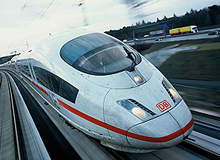
Having successfully passed a series of safety tests in the Eurotunnel, Deutsche Bahn (DB) intends to facilitate the travel of over 1m passengers from London to Frankfurt each year.
Following this successful test run through the Channel Tunnel, DB presented the ICE (class 407) from Siemens, which is the most advanced high-speed train in Europe at London’s St Pancras station for the first time on 19 October 2010.
London to Frankfurt on ICE
The new ICE 3 (class 407) is now considered the most modern high-speed train in Europe and has been built according to the latest safety standards. With its top speed of 320km per hour DB has ordered 15 of the ICE high-speed trains from Siemens at a total cost of €500m.
The company’s long-distance passenger services are becoming increasingly international. Around 80 cities can now be reached directly from Germany. The 220 services (70% of these involve ICE or other high-speed trains and DB already has more than 60 ICE trains operating on European lines) are used by over 40,000 passengers a day and over the next few years, DB intends to expand that international network even further.
Europe will see the rollout of regular services between Germany, the Netherlands and London and the plan is for three pairs of trains to run per day between the two cities as of 2013.
Rail equals mobility
The journey time of around five hours from Frankfurt to London is expected to be very attractive to both business and holiday travellers. Following the rollout of Franco-German high-speed services in June 2007, around 4m people have used these fast trains.
Passenger figures for 2009 were reportedly up by 5% (year-on-year) and the Stuttgart–Paris route showed that rail has increased market share, ahead of air travel, to 59%.
Statistics show that about every third person travelling between Frankfurt (Main) and Paris now opts to travel by rail.
Many see current demand for cheaper travel as the zeitgeist for introducing more flexibility into rail travel across Europe. “Mobility doesn’t end at national borders; passengers don’t want to change at borders these days,” says Chairman of the DB Management Board Dr Rüdiger Grube, going on to explain how 1.1m passengers each year from the Frankfurt / Cologne region to London is a “huge market volume” that the company cannot ignore.
Three return train journeys (outward and return) will be incorporated between Frankfurt and London via Cologne, Brussels and Lille. This will include connections from Amsterdam via Rotterdam to London.
New safety rules
The fact that the ICE trains will be linking London and Frankfurt is a historic occasion for rail travel as previously Eurostar had been the only company with permission to use the 31.4-mile tunnel (which is owned by France’s SNCF, Belgium’s SNCB and Britain’s London and Continental Railways group).
Furthermore, safety conditions called for trains to be at least 375m because the exits are spaced 375m apart. However, Dr Rüdiger Grube, German Transportation Minister Peter Ramsauer, French Transportation Minister Dominique Bussereau and the head of the French rail operator, Guillaume Pepy, made an agreement to alter the safety rules.
The ICE train is made up from two locomotives that are bolted together, which means passengers cannot move through the length of the train and DB had to show that this design would not affect a smooth and safe evacuation procedure. October’s tests proved that passengers could be evacuated safely. “With the ICE 3 (class 407) we will be using the most advanced high-speed trains in Europe along this route, which will meet the highest standards of safety, passenger comfort and efficiency,” says Ulrich Homburg, Member of the DB Management Board for Passenger Transport.
Protectionism claims
Previous to the ICE being accepted by Eurostar, the company had traditionally relied on French engineering company Alstom for its rolling stock, until then the only company making trains to run through the Channel Tunnel. This decision has lead Alstom to challenge the fairness of this and a London lawsuit challenging the tender has been set for October 2011.
While some headlines stated Eurostar has dragged Germany and France into a protectionist row, Jacques Gounon, chief executive officer of Groupe Eurotunnel SA was keen to point out on Bloomberg Television’s The Pulse that the competition was not really between Eurostar and DB at all, but between high-speed railways and airlines, with his opinion being that railways will ultimately defeat airlines.
This is an area that Dr Grube agrees with: “By making full use of the opportunities afforded by the liberalisation of the European rail transport market we are able to offer our customers genuine alternatives to air travel,” he says. The Channel Tunnel regulations are now under revision in a standard process as they are basically unchanged for almost 20 years.
Furthermore, DB is planning to invest a multi-million Euro amount to further adapt the trains to achieve optimal interoperability with the safety infrastructure of the Channel Tunnel.
Rail vs. air
The London to Frankfurt air market is one of the biggest air travel markets in Europe and therefore direct services and decent travel times make travelling by rail very attractive. Not only that, but as passengers increasingly wish to reduce their carbon footprint, a rail traveller can generate approximately 80% less carbon emissions than an air passenger.
In addition the ICE trains serve four-course meals, offer broadband access and no airport security hassle – all of which will appeal to business travellers operating in Frankfurt and London.
DB intend to run one eight-car train from Frankfurt via Cologne and another from Amsterdam with the units joining together in Lille to form a single train that would be charged only once for transiting the tunnel. Eurostar would be filling 900-seat units, which has been described as the train equivalent of an Airbus SAS A380 super jumbo plane.



